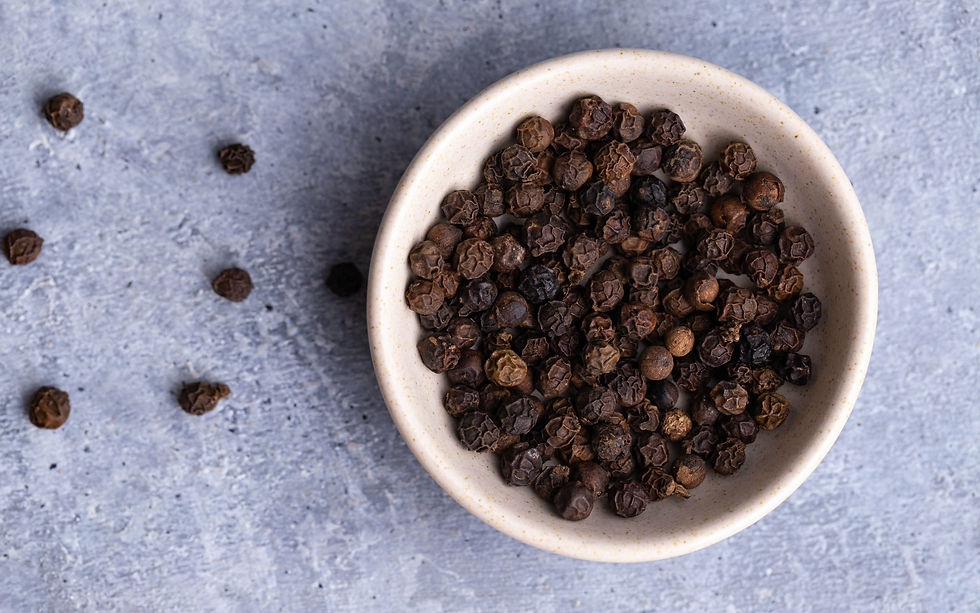Story of Pepper: the spice that lured Europeans to India
- Manish -
- Apr 21, 2024
- 3 min read

Welcome to the fascinating history of pepper, its role in ancient civilizations, trade networks, and cultural impact. In this blog I will delve briefly into the origins of pepper, its importance in trade routes, and its influence on medicine, cuisine and culture
Pepper has a rich history that dates back thousands of years. The cultivation of pepper began in India, where it was native, and traders introduced it to Indonesia. Two species of pepper were domesticated: long pepper (Piper longum) in northeast India and black pepper (Piper nigrum) in southwest India. Pepper played a central role in ancient Indian and Chinese medicines and became a critical component of Roman and medieval European cuisine. Its trade routes and economic significance are well-documented, with pepper being traded overland from India to China as early as the 2nd century BCE. The spice's allure and value led to explorations by Vasco da Gama and Christopher Columbus, further expanding its reach and importance in global trade.
Vasco da Gama's expedition around the Cape of Africa to the Indian Ocean opened up direct sea routes to the spice-rich lands of India, including pepper-producing regions. Christopher Columbus, on his voyage across the Atlantic Ocean to the New World, also sought to find new trade routes for spices like pepper. These explorations and trade ventures introduced Europeans to the exotic spices of the East, including pepper, which eventually became highly sought after and valuable commodities in European markets.

The decline in the consumption of pepper in Europe during the mid-17th century can be attributed to several factors. One significant reason was the introduction of new beverages and stimulants like tea, coffee, chocolate, and tobacco, which offered novel taste sensations and, in some cases, addictive properties. These new commodities competed with traditional spices like pepper, leading to a shift in consumer preferences. Additionally, changes in dietary habits, evolving culinary trends, and the availability of alternative flavorings may have contributed to the decreased demand for pepper. The emergence of different trade routes and the exploration of new territories also diversified the spice market, offering Europeans access to a wider range of exotic ingredients beyond pepper. These factors collectively led to a decline in the popularity and consumption of pepper in Europe during that period.
Pepper has a long history of medicinal use in various cultures, particularly in ancient India and China. In Ayurvedic medicine, an ancient Indian healing system, pepper was considered a key component and used for its therapeutic properties. Pepper was believed to have digestive benefits, stimulate appetite, improve circulation, and aid in respiratory conditions. It was also used in traditional Chinese medicine for similar purposes, including treating colds, coughs, and digestive issues.
Pepper is a versatile spice used in various cuisines around the world to add flavour, aroma, and a hint of spiciness to dishes. Here are some examples of how different cuisines incorporate pepper:
1. Indian Cuisine: Pepper is a common spice in Indian cuisine, used in both whole and ground forms. It is a key ingredient in many spice blends like garam masala and is used in curries, marinades, chutneys, and pickles.
2. Chinese Cuisine: In Chinese cooking, pepper is often used in stir-fries, soups, and marinades. Sichuan peppercorns, known for their numbing and tingling sensation, are a staple in Sichuan cuisine.
3. Italian Cuisine: Pepper plays a prominent role in Italian cuisine, especially in dishes like pasta, salads, and grilled meats. Freshly ground black pepper is often added as a finishing touch to many Italian dishes.
4. French Cuisine: French cuisine uses pepper in a variety of dishes, from sauces and soups to meats and vegetables. Peppercorns are sometimes crushed and used as a crust on meats like steak.
5. Mexican Cuisine: Pepper is used in Mexican cuisine to add heat and flavor to dishes like salsas, marinades, and spice rubs for meats. Chipotle peppers, made from smoked and dried jalapeños, are a popular ingredient.
6. Thai Cuisine: Thai cuisine often incorporates black and white pepper in curries, stir-fries, and noodle dishes. White pepper is commonly used in Thai soups and seafood dishes.
7. Middle Eastern Cuisine: Pepper is used in Middle Eastern cuisine to season meats, rice dishes, and salads. It is often combined with other spices like cumin, coriander, and cinnamon.
8. American Cuisine: In American cuisine, pepper is used in a wide range of dishes, from barbecue rubs and chili to seasoning for grilled meats and vegetables. It is a staple spice in many American households.
Let me know how do you use pepper in your cuisines?
Happy Cooking !





Comments